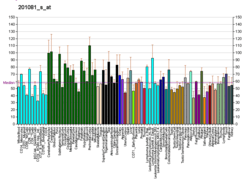PIP4K2B
Phosphatidylinositol-5-phosphate 4-kinase type-2 beta is an enzyme that in humans is encoded by the PIP4K2B gene.[5][6][7][8]
The protein encoded by this gene catalyzes the phosphorylation of phosphatidylinositol 4-phosphate on the fifth hydroxyl of the myo-inositol ring to form phosphatidylinositol 4,5-bisphosphate. This gene is a member of the phosphatidylinositol-4-phosphate 5-kinase family. The encoded protein sequence does not show similarity to other kinases, but the protein does exhibit kinase activity. Additionally, the encoded protein interacts with p55 TNF receptor.[8]
Interactions
PIP4K2B has been shown to interact with TNFRSF1A.[5] In addition, PIP4K2B has been shown to interact with PIP4K2A and may modulate the cellular localisation of PIP4K2A.[9]
Structure
The structure of PIP4K2B has been determined through X-ray crystallography.[10]
References
- ENSG00000276293 GRCh38: Ensembl release 89: ENSG00000277292, ENSG00000276293 - Ensembl, May 2017
- GRCm38: Ensembl release 89: ENSMUSG00000018547 - Ensembl, May 2017
- "Human PubMed Reference:". National Center for Biotechnology Information, U.S. National Library of Medicine.
- "Mouse PubMed Reference:". National Center for Biotechnology Information, U.S. National Library of Medicine.
- Castellino AM, Parker GJ, Boronenkov IV, Anderson RA, Chao MV (Apr 1997). "A novel interaction between the juxtamembrane region of the p55 tumor necrosis factor receptor and phosphatidylinositol-4-phosphate 5-kinase". J Biol Chem. 272 (9): 5861–70. doi:10.1074/jbc.272.9.5861. PMID 9038203.
- Luoh SW, Venkatesan N, Tripathi R (Feb 2004). "Overexpression of the amplified Pip4k2beta gene from 17q11-12 in breast cancer cells confers proliferation advantage". Oncogene. 23 (7): 1354–63. doi:10.1038/sj.onc.1207251. PMID 14691457.
- Rameh LE, Tolias KF, Duckworth BC, Cantley LC (Nov 1997). "A new pathway for synthesis of phosphatidylinositol-4,5-bisphosphate". Nature. 390 (6656): 192–6. Bibcode:1997Natur.390..192R. doi:10.1038/36621. PMID 9367159.
- "Entrez Gene: PIP5K2B phosphatidylinositol-4-phosphate 5-kinase, type II, beta".
- Bultsma, Yvette; Keune, Willem-Jan; Divecha, Nullin (2010-09-01). "PIP4Kβ interacts with and modulates nuclear localization of the high-activity PtdIns5P-4-kinase isoform PIP4Kα". Biochemical Journal. 430 (2): 223–235. doi:10.1042/bj20100341. ISSN 0264-6021. PMID 20583997.
- Rao, Vibha D; Misra, Saurav; Boronenkov, Igor V; Anderson, Richard A; Hurley, James H (1998). "Structure of Type IIβ Phosphatidylinositol Phosphate Kinase". Cell. 94 (6): 829–839. doi:10.1016/s0092-8674(00)81741-9. PMID 9753329.
Further reading
- Niiro H, Clark EA (2003). "Branches of the B cell antigen receptor pathway are directed by protein conduits Bam32 and Carma1". Immunity. 19 (5): 637–40. doi:10.1016/S1074-7613(03)00303-0. PMID 14614850.
- Carpenter CL (2004). "Btk-dependent regulation of phosphoinositide synthesis". Biochem. Soc. Trans. 32 (Pt 2): 326–9. doi:10.1042/BST0320326. PMID 15046600.
- Rao VD, Misra S, Boronenkov IV, et al. (1998). "Structure of type IIbeta phosphatidylinositol phosphate kinase: a protein kinase fold flattened for interfacial phosphorylation". Cell. 94 (6): 829–39. doi:10.1016/S0092-8674(00)81741-9. PMID 9753329.
- Boronenkov IV, Loijens JC, Umeda M, Anderson RA (1999). "Phosphoinositide signaling pathways in nuclei are associated with nuclear speckles containing pre-mRNA processing factors". Mol. Biol. Cell. 9 (12): 3547–60. doi:10.1091/mbc.9.12.3547. PMC 25675. PMID 9843587.
- Kutsenko AS, Gizatullin RZ, Al-Amin AN, et al. (2002). "NotI flanking sequences: a tool for gene discovery and verification of the human genome". Nucleic Acids Res. 30 (14): 3163–70. doi:10.1093/nar/gkf428. PMC 135748. PMID 12136098.
- Strausberg RL, Feingold EA, Grouse LH, et al. (2003). "Generation and initial analysis of more than 15,000 full-length human and mouse cDNA sequences". Proc. Natl. Acad. Sci. U.S.A. 99 (26): 16899–903. Bibcode:2002PNAS...9916899M. doi:10.1073/pnas.242603899. PMC 139241. PMID 12477932.
- Gerhard DS, Wagner L, Feingold EA, et al. (2004). "The status, quality, and expansion of the NIH full-length cDNA project: the Mammalian Gene Collection (MGC)". Genome Res. 14 (10B): 2121–7. doi:10.1101/gr.2596504. PMC 528928. PMID 15489334.
- Rual JF, Venkatesan K, Hao T, et al. (2005). "Towards a proteome-scale map of the human protein-protein interaction network". Nature. 437 (7062): 1173–8. Bibcode:2005Natur.437.1173R. doi:10.1038/nature04209. PMID 16189514.
- Lim J, Hao T, Shaw C, et al. (2006). "A protein-protein interaction network for human inherited ataxias and disorders of Purkinje cell degeneration". Cell. 125 (4): 801–14. doi:10.1016/j.cell.2006.03.032. PMID 16713569.
- Richardson JP, Wang M, Clarke JH, et al. (2007). "Genomic tagging of endogenous type IIbeta phosphatidylinositol 5-phosphate 4-kinase in DT40 cells reveals a nuclear localisation". Cell. Signal. 19 (6): 1309–14. doi:10.1016/j.cellsig.2007.01.010. PMC 1868964. PMID 17303380.






